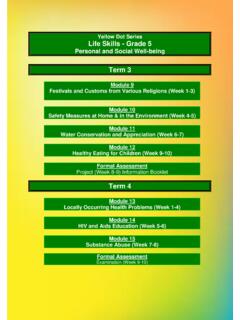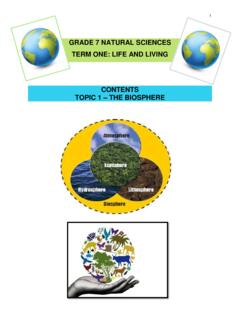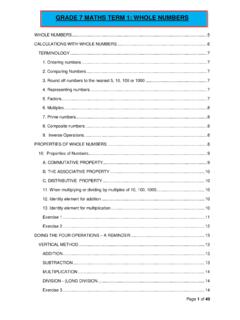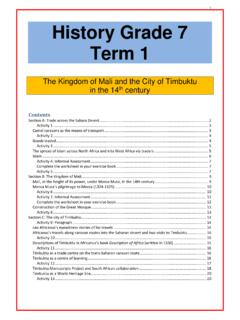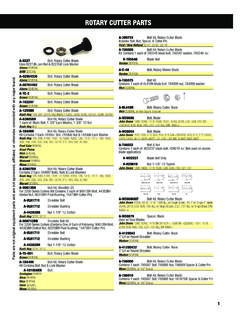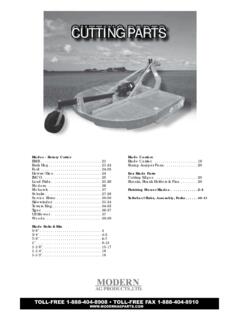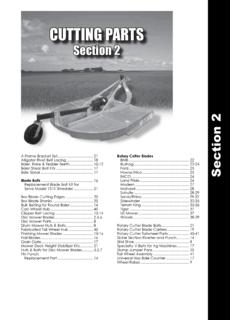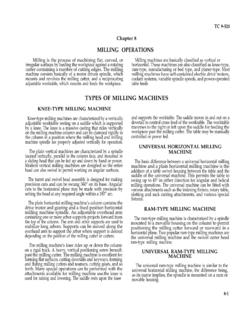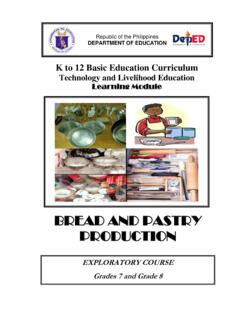Transcription of GRADE 7 TECHNOLOGY: TERM 3 - Brackenham Primary …
1 1 GM 2018 GRADE 7 technology : term 3 Contents TOPIC 1: ELECTRICAL SYSTEMS AND CONTROL .. 2 What is magnetism? .. 2 TOPIC 2: RECYCLING .. 4 What is recycling? .. 4 TOPIC 3: ELECTRICITY AND ELECTRICAL SYSTEMS .. 6 Simple Electric Circuits .. 6 Electromagnets .. 7 Something to try at home: Making an electromagnet .. 7 TOPIC 4: MECHANICAL SYSTEMS AND CONTROL .. 8 Cranks .. 8 Machines use four basic types of movements: .. 10 Pulleys .. 12 Strengthening Frame Structures .. 14 PAT: Examine pictures of cranes .. 14 MODEL CRANES .. 14 2 GM 2018 TOPIC 1: ELECTRICAL SYSTEMS AND CONTROL What is magnetism? Magnetism is the force that pulls (attracts) or pushes (repels) an object which contains metal towards, or away from, a magnet. A magnet has an area around it over which it can exert a force on objects. The further away the object is from the magnet, the weaker the force.
2 This area is called the magnetic field. A permanent magnet is a piece of magnetic material that retains or keeps it magnetism after it is removed from a magnetic field. In other words its magnetism is always there it is permanent. Find more information on the history of magnets by looking at the following website: Watch a video on you tube titled Magnets and Magnetism by following the link: Activity 1: Practical Investigation Find out which substances will stick to a permanent magnet. Record your findings on a table such as the one below. SUBSTANCE Magnetic Non-magnetic Wood Plastic Iron Paper Copper Rubber shoe sole Aluminium or foil Silver coin 3 GM 2018 Activity 2: The magnetic field In the image below iron filings are used to illustrate the pattern that a magnetic field exerts.
3 1. The iron filings would be placed on a sheet of paper. 2. The magnet would be placed under the paper. 3. You will use your finger to push the filings gently over the page. What do you think happens? A magnetic field forms. 4. Try to identify the North and South Poles as indicated on the left and on the right of the image above. 5. Write two sentences explaining what you think is happening in the images above. 6. Answer the following questions: a. Why is it useful to be aware of magnetism? (1) b. Do all magnets have a South and a North Pole? Why do you say so? (2) c. Are all materials attracted to a magnet? Give a reason. (2) d. What materials would not be attracted to a magnet? (2) e. Make a freehand sketch, in your book, showing how a magnetic field forms around a single magnet.
4 (3) Total: 10 . Iron filings on the bottom of a horseshoe magnet. A Horseshoe magnet Iron filings showing the magnetic field created by magnets. Can you sport the reason for the difference in patterns? 4 GM 2018 TOPIC 2: RECYCLING What is recycling? Recycling is the process of making or manufacturing new products from a product that has served its original purpose. If these used products are disposed of in an appropriate, environmentally friendly way, the process of recycling has been set in motion. Recycling is an excellent way to save energy and conserve the environment. DID YOU KNOW? One recycled tin can save enough energy to power a TV for three hours. One recycled glass bottle would save enough energy to power a computer for 25 minutes.
5 One recycled plastic bottle would save enough energy to power a 60-watt light bulb for three hours. 70% less energy is required to recycle paper compared to making it from raw materials. A great deal of waste that could be recycled ends up in landfill sites. This is harmful to the environment. Some interesting facts Up to 60% of the rubbish that ends up in the dustbin could be recycled. On average, 16% of the money you spend on a product pays for the packaging, which ultimately ends up in the rubbish. As much as 50% of waste in the average dustbin could be made into compost. Up to 80% of a motor vehicle can be recycled. 9 out of 10 people would recycle more if it was made easier. 5 GM 2018 Activity 3: Recycling scheme for your school Work in a group of 4-6 learners. Discuss and write down some suggestions that you can think of to raise funds for your school, by recycling the waste on your school grounds.
6 1. Choose a NAME for your group of RECYCLERS. Use your INITIATIVE and make it INTERESTING. 2. Draw a LOGO for your group and make up a SLOGAN which you will present to the rest of the class. 3. Answer the questions below. Write these answers in your books or on your poster. a. Where will you find containers to keep the different waste in? (2) b. Can the containers be placed at any place on the school grounds or do you have to work out a plan for placing them? (2) c. Who will empty the containers? (2) d. Will they be emptied at a specific time of the day or during school? (2) e. Can you think of a recycler who will pay your school for collecting the waste? (2) f. How can the school use the profit money gained through the scheme? (2) Total: 12 RECYCLE RE-USE REDUCE 6 GM 2018 TOPIC 3: ELECTRICITY AND ELECTRICAL SYSTEMS Simple Electric Circuits The simplest form of electrical circuit is when an energy source (such as a battery) is connected to a load, such as a light bulb or a resistor, as is in the image below.
7 Activity 4: Drawing a simple circuit Draw a circuit in your book, similar to the circuits below. Use the correct symbols for labelling your components and say what each of the symbols mean, a battery is used to connect to the electrical wire. 7 GM 2018 Electromagnets An electromagnet is a type of magnet in which the flow of electric current produces a magnetic field. The magnetic field disappears when the current is turned off. Electromagnetism is the foundation of a wide range of modern technology . You can make a simple electromagnet by winding insulated copper wire around an iron nail. The coiled copper wire is called a solenoid. When an electric current flows through the solenoid, it creates a magnetic field. The iron core amplifies this magnetic core.
8 When we switch the current off, the magnetic field fades away. Something to try at home: Making an electromagnet Please ask an adult to assist you if you try this at home. If you want to make an electromagnet, these are the steps you must follow: You will need: A large iron nail (approximately 50mm or 60mm long) Thinly coated copper wire A dry-cell battery, a penlight battery Electrical tape A pair of scissors or a wire cutter Iron filings, paper clips and other magnetic items. Method: 1. Wrap the thinly coated copper wire around the nail. 2. Use the scissors, or wire cutter , to cut the excess wire. 3. Leave at least 5mm of wire uncovered at both ends of the nail. 4. The wires must not overlap when you wrap them around the nail. 5. Attach the wires to the battery terminals by following these steps: a.
9 Peel the plastic coverings off the copper wire. b. Attach the one end to the positive terminal of the battery. 8 GM 2018 c. Attach the other end to the negative terminal of the battery. d. Use electric tape to stick both ends of the wire to the battery terminals to keep them in place. 6. Use the iron filings, paper clips and other magnetic items to test the electromagnet. Some interesting facts about electromagnets Electromagnets work as long as there is electricity running through a wire, as this will automatically allow a magnetic field to be generated. The magnetic field that the electromagnet creates is only temporary. As long as there is a continuous flow of electrons, the electromagnet will work. Ordinary magnets, on the other hand, do not need electric current to work. TOPIC 4: MECHANICAL SYSTEMS AND CONTROL A lever is a simple machine consisting of a rigid bar resting on a pivot or a fulcrum.
10 Levers are used to make work easier for us. Machines can be simple or complex machines. Simple machines are basic machines known as mechanisms. Complex machines are made up of many parts that work together. When parts work together to carry out the same function, we call it a system. Therefore, a complex machine is a mechanical system. The parts that make up this system are either simple machines or mechanisms. Cranks A crank is a mechanism. It is a bar or rod that has one or more right-angle bends in it. The bar or rod is normally attached to a pivot at one end and rotates in a complete circle. The most common crank is the crank handle. A rod that has a number of cranks is called a crank shaft. A manual egg beater A fishing rod 9 GM 2018 A crank is a useful mechanism.
